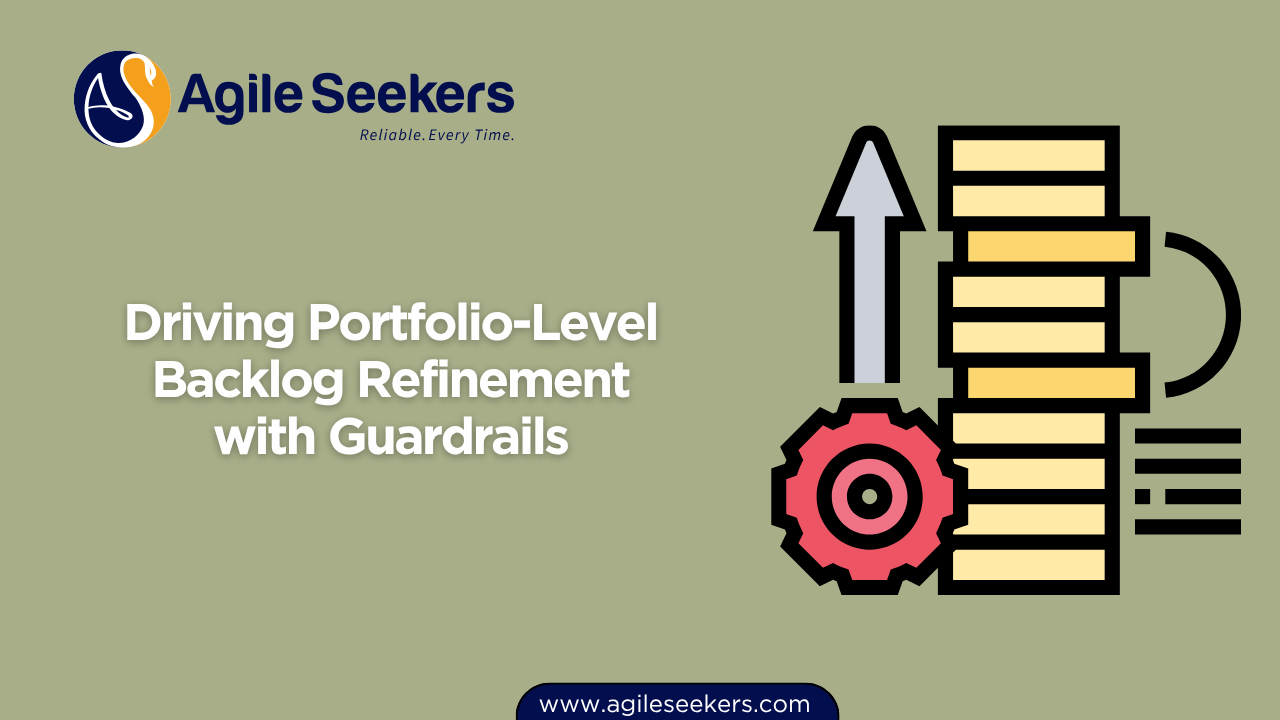Driving Portfolio-Level Backlog Refinement with Guardrails

Backlog refinement at the portfolio level is more than just updating Epics or prioritizing investments. It requires strategic alignment, economic justification, and governance that doesn’t slow teams down. This is where guardrails in the SAFe framework become indispensable.
Guardrails provide lightweight governance to ensure that portfolio-level decision-making aligns with organizational goals while still enabling Lean-Agile autonomy. In this post, we'll explore how guardrails guide portfolio-level backlog refinement and help drive value delivery across the enterprise.
What is Portfolio-Level Backlog Refinement?
At the portfolio level, the backlog includes Epics and Enablers that impact multiple Agile Release Trains (ARTs). Refinement here is not about detailing user stories—it’s about analyzing, scoping, and prioritizing work based on enterprise strategy, budgeting constraints, and delivery capacity.
Backlog refinement at this level involves:
-
Identifying and prioritizing Epics and portfolio-level Enablers
-
Aligning Epics to strategic themes and value streams
-
Applying the Weighted Shortest Job First (WSJF) method
-
Ensuring Lean Budget Guardrails are respected
-
Engaging Enterprise Architects, Epic Owners, and Product Management
This process is supported by portfolio Kanban systems, Lean budgeting, and most importantly, guardrails.
Understanding Guardrails in SAFe
Guardrails are a set of guidelines in the SAFe framework that help Lean Portfolio Management (LPM) maintain alignment without micromanaging. These are not rigid rules but dynamic boundaries that support decentralized decision-making while minimizing risk.
The four primary SAFe guardrails include:
-
Capacity Allocation
-
WSJF for Epic Prioritization
-
Approval of Significant Initiatives
-
Continuous Business Owner Engagement
Each guardrail influences how backlog refinement is conducted at the portfolio level.
Applying Guardrails During Backlog Refinement
1. Capacity Allocation: Balancing Investment Horizons
Guardrails encourage proactive capacity allocation across different types of work: Run-the-business, Transform-the-business, and Infrastructure. This helps avoid over-investment in shiny new features while neglecting system health.
For example, setting aside 20% of the portfolio backlog for technical enablers ensures future scalability. During refinement, Epic Owners must identify whether their work aligns with transformation, innovation, or foundational initiatives.
A strong grasp of strategic balancing is essential for those pursuing SAFe POPM Certification, as this principle plays a critical role in value stream alignment.
2. WSJF for Prioritizing Epics
Applying WSJF ensures prioritization reflects both the value and urgency of Epics. This involves calculating Cost of Delay and dividing it by job size. The result? High-value, quick-win Epics rise to the top.
Guardrails recommend standardizing WSJF scoring across portfolios to avoid bias. For instance, two Epics of equal business value might have different WSJF scores due to size or risk, which directly affects refinement outcomes.
You can explore this method in more detail via Scaled Agile's WSJF article.
3. Approval for Significant Initiatives
Not every Epic goes straight into execution. SAFe suggests that initiatives beyond a certain budget threshold or strategic impact must be reviewed by the LPM function.
Guardrails define these thresholds clearly, allowing refinement meetings to filter which Epics can move forward autonomously and which need escalation. This keeps the refinement process focused while maintaining executive alignment.
Aspiring Product Owners who complete SAFe Product Owner Certification are trained to navigate this governance structure effectively.
4. Continuous Business Owner Engagement
Backlog refinement cannot succeed in isolation. Guardrails emphasize regular engagement with Business Owners to validate priorities, assess ROI, and surface potential risks.
In practical terms, this means involving Business Owners during Epic refinement sessions to:
-
Confirm alignment with OKRs or strategic themes
-
Challenge WSJF inputs
-
Highlight external dependencies
This level of engagement ensures backlog items are not just prioritized, but validated and endorsed.
Refinement Workflow in Practice
Here's a simplified step-by-step example of how guardrails influence portfolio backlog refinement:
-
Epic Identification: Epic Owner submits a new transformation Epic.
-
Initial WSJF Scoring: Stakeholders score WSJF collaboratively.
-
Budget Check: The Epic is within threshold; no additional approval needed.
-
Capacity Allocation Review: Portfolio Management checks that the Epic fits within allocated transformation budget.
-
Business Owner Review: BOs agree with ROI projections and risk assumptions.
-
Prioritization: Epic enters top 5 of the Portfolio Backlog.
This entire process respects the autonomy of decentralized teams while ensuring strategic oversight.
Role of the SAFe POPM in Portfolio-Level Refinement
While Product Owners and Product Managers usually operate at the program level, understanding portfolio guardrails is vital. Many enterprises involve senior POPMs in portfolio-level discussions due to their cross-ART context.
For those undertaking SAFe Product Owner/Manager Certification, mastering this topic provides a competitive edge, especially when collaborating with Lean Portfolio Management.
Their role includes:
-
Advocating for ART-level Epics that align with business objectives
-
Ensuring transparency between Portfolio and Program backlogs
-
Participating in WSJF scoring and Epic definition
Best Practices for Driving Refinement with Guardrails
-
Institutionalize WSJF: Make WSJF a habit, not an event. Encourage quarterly reviews.
-
Use Portfolio Kanban: Visualize the status of Epics through funnel, analysis, and backlog stages.
-
Measure Guardrail Effectiveness: Track how often governance thresholds are breached.
-
Standardize Templates: Use consistent templates for Epic hypotheses and Lean business cases.
-
Foster Lean Budget Conversations: Create safe spaces for dialogue on funding priorities.
Wrapping Up
Driving portfolio-level backlog refinement with guardrails is not about adding process overhead. It’s about aligning investment with strategy while empowering decentralized decision-making. Done right, guardrails ensure prioritization is justified, governance is respected, and value flows continuously.
This balance is core to effective Agile Portfolio Management and central to the competencies developed through SAFe POPM training.
For further reading, check out this practical guide on Lean Governance in Agile Portfolios, which complements SAFe’s approach.
Also read - Managing Feature Toggle Strategies in SAFe Continuous Delivery Pipeline
Also see - Using Value Stream KPIs to Measure System-Level Flow and Throughput




















